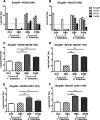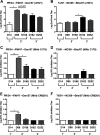Sequential Infection in Ferrets with Antigenically Distinct Seasonal H1N1 Influenza Viruses Boosts Hemagglutinin Stalk-Specific Antibodies
- PMID: 26559834
- PMCID: PMC4702689
- DOI: 10.1128/JVI.02372-15
Sequential Infection in Ferrets with Antigenically Distinct Seasonal H1N1 Influenza Viruses Boosts Hemagglutinin Stalk-Specific Antibodies
Abstract
Broadly reactive antibodies targeting the conserved hemagglutinin (HA) stalk region are elicited following sequential infection or vaccination with influenza viruses belonging to divergent subtypes and/or expressing antigenically distinct HA globular head domains. Here, we demonstrate, through the use of novel chimeric HA proteins and competitive binding assays, that sequential infection of ferrets with antigenically distinct seasonal H1N1 (sH1N1) influenza virus isolates induced an HA stalk-specific antibody response. Additionally, stalk-specific antibody titers were boosted following sequential infection with antigenically distinct sH1N1 isolates in spite of preexisting, cross-reactive, HA-specific antibody titers. Despite a decline in stalk-specific serum antibody titers, sequential sH1N1 influenza virus-infected ferrets were protected from challenge with a novel H1N1 influenza virus (A/California/07/2009), and these ferrets poorly transmitted the virus to naive contacts. Collectively, these findings indicate that HA stalk-specific antibodies are commonly elicited in ferrets following sequential infection with antigenically distinct sH1N1 influenza virus isolates lacking HA receptor-binding site cross-reactivity and can protect ferrets against a pathogenic novel H1N1 virus.
Importance: The influenza virus hemagglutinin (HA) is a major target of the humoral immune response following infection and/or seasonal vaccination. While antibodies targeting the receptor-binding pocket of HA possess strong neutralization capacities, these antibodies are largely strain specific and do not confer protection against antigenic drift variant or novel HA subtype-expressing viruses. In contrast, antibodies targeting the conserved stalk region of HA exhibit broader reactivity among viruses within and among influenza virus subtypes. Here, we show that sequential infection of ferrets with antigenically distinct seasonal H1N1 influenza viruses boosts the antibody responses directed at the HA stalk region. Moreover, ferrets possessing HA stalk-specific antibody were protected against novel H1N1 virus infection and did not transmit the virus to naive contacts.
Copyright © 2015, American Society for Microbiology. All Rights Reserved.
Figures







Similar articles
-
Infection of Ferrets with Influenza Virus Elicits a Light Chain-Biased Antibody Response against Hemagglutinin.J Immunol. 2017 Dec 1;199(11):3798-3807. doi: 10.4049/jimmunol.1701174. Epub 2017 Oct 27. J Immunol. 2017. PMID: 29079697
-
Elicitation of Protective Antibodies against 20 Years of Future H3N2 Cocirculating Influenza Virus Variants in Ferrets Preimmune to Historical H3N2 Influenza Viruses.J Virol. 2019 Jan 17;93(3):e00946-18. doi: 10.1128/JVI.00946-18. Print 2019 Feb 1. J Virol. 2019. PMID: 30429350 Free PMC article.
-
Sequential seasonal H1N1 influenza virus infections protect ferrets against novel 2009 H1N1 influenza virus.J Virol. 2013 Feb;87(3):1400-10. doi: 10.1128/JVI.02257-12. Epub 2012 Oct 31. J Virol. 2013. PMID: 23115287 Free PMC article.
-
ADCC: An underappreciated correlate of cross-protection against influenza?Front Immunol. 2023 Feb 22;14:1130725. doi: 10.3389/fimmu.2023.1130725. eCollection 2023. Front Immunol. 2023. PMID: 36911705 Free PMC article. Review.
-
Role of Memory B Cells in Hemagglutinin-Specific Antibody Production Following Human Influenza A Virus Infection.Pathogens. 2019 Sep 28;8(4):167. doi: 10.3390/pathogens8040167. Pathogens. 2019. PMID: 31569328 Free PMC article. Review.
Cited by
-
Evaluation of Next-Generation H3 Influenza Vaccines in Ferrets Pre-Immune to Historical H3N2 Viruses.Front Immunol. 2021 Aug 12;12:707339. doi: 10.3389/fimmu.2021.707339. eCollection 2021. Front Immunol. 2021. PMID: 34475872 Free PMC article.
-
Original antigenic sin priming of influenza virus hemagglutinin stalk antibodies.Proc Natl Acad Sci U S A. 2020 Jul 21;117(29):17221-17227. doi: 10.1073/pnas.1920321117. Epub 2020 Jul 6. Proc Natl Acad Sci U S A. 2020. PMID: 32631992 Free PMC article.
-
Cross-Protective Immune Responses Induced by Sequential Influenza Virus Infection and by Sequential Vaccination With Inactivated Influenza Vaccines.Front Immunol. 2018 Oct 9;9:2312. doi: 10.3389/fimmu.2018.02312. eCollection 2018. Front Immunol. 2018. PMID: 30356772 Free PMC article.
-
Computationally optimized broadly reactive vaccine based upon swine H1N1 influenza hemagglutinin sequences protects against both swine and human isolated viruses.Hum Vaccin Immunother. 2019;15(9):2013-2029. doi: 10.1080/21645515.2019.1653743. Hum Vaccin Immunother. 2019. PMID: 31448974 Free PMC article.
-
Computationally Optimized Broadly Reactive H2 HA Influenza Vaccines Elicited Broadly Cross-Reactive Antibodies and Protected Mice from Viral Challenges.J Virol. 2020 Dec 22;95(2):e01526-20. doi: 10.1128/JVI.01526-20. Print 2020 Dec 22. J Virol. 2020. PMID: 33115871 Free PMC article.
References
-
- Gerhard W. 2001. The role of the antibody response in influenza virus infection. Curr Top Microbiol Immunol 260:171–190. - PubMed
Publication types
MeSH terms
Substances
Grants and funding
LinkOut - more resources
Full Text Sources
Other Literature Sources

